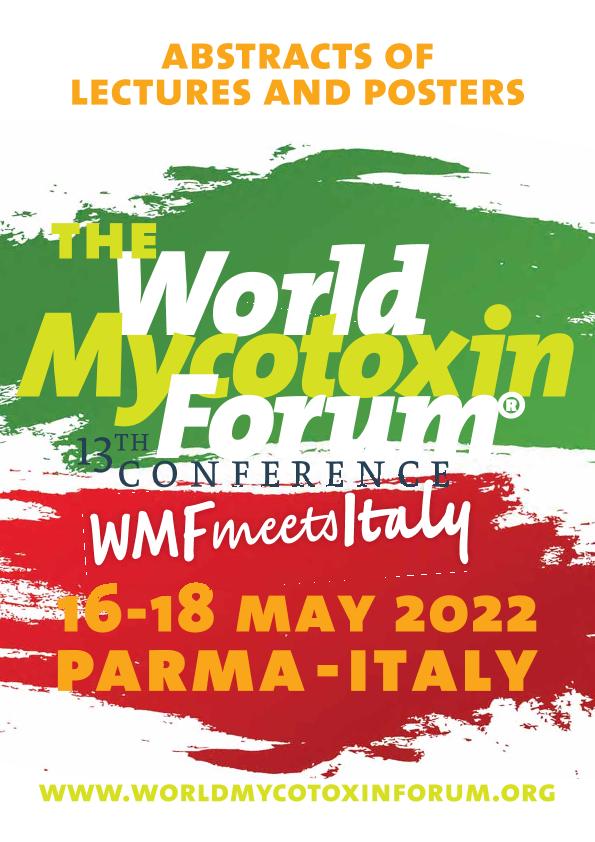Evento
Effect of water activity and temperature on growth and trichothecene production by Fusarium cerealis isolated from durum wheat grains
Erazo, Jessica Gabriela ; Palacios, Sofia Alejendra
; Palacios, Sofia Alejendra ; del Canto, Agostina
; del Canto, Agostina ; Plem, Silvana Cristina
; Plem, Silvana Cristina ; Ramirez, Maria Laura
; Ramirez, Maria Laura ; Torres, Adriana Mabel
; Torres, Adriana Mabel
 ; Palacios, Sofia Alejendra
; Palacios, Sofia Alejendra ; del Canto, Agostina
; del Canto, Agostina ; Plem, Silvana Cristina
; Plem, Silvana Cristina ; Ramirez, Maria Laura
; Ramirez, Maria Laura ; Torres, Adriana Mabel
; Torres, Adriana Mabel
Tipo del evento:
Conferencia
Nombre del evento:
The World Mycotoxin Forum 13th Conference
Fecha del evento:
16/05/2022
Institución Organizadora:
Universidad de Parma;
Título del Libro:
Abstracts of lectures and posters: World Mycotoxin Forum. 13th conference
Editorial:
Bastiaanse Communication
Idioma:
Inglés
Clasificación temática:
Resumen
The major pathogen associated to fusarium head blight (FHB) is included in the Fusarium graminearum species complex. However, recently there have been reports of F. cerealis causing the disease in wheat and barley. This pathogen is able to produce deoxynivalenol (DON) and nivalenol (NIV). Nevertheless, the effect of environmental factors on growth and mycotoxin production by this species have not been studied so far. The aim of this study was to determine the effect of water activity (aw, 0.99?0.90) and temperature (15, 20, 25 and 30°C) on growth and DON and NIV production by three F. cerealis strains (RCFG6046, RCFG6029, RCFG6076) isolated from durum wheat grains. A wheat-based medium was used and adjusted to the different aW with glycerol. Plates were inoculated centrally and incubated during 28 days (three replicates per treatment). Growth rate (mm/day) was determined and mycotoxin production was analyzed after the incubation period by HPLC-UV. All strains were able to growth at all temperatures and all aW except at 0.90. Maximum growth was observed at 0.99 and 25°C and it decreased as water availability was reduced. Minimum growth was observed at 0.93 aW and 15°C. Mycotoxin production was strain dependent. Strains RCFG6046 and RCFG6076 produced both DON and NIV, being NIV the most produced. While RCFG6029 just produced DON. Strains RCFG6029 and RCFG6046 just produced DON at the optimum growth condition unlike RCFG6076 which produced only NIV. For some conditions, RCFG6076 was able to produce both toxins simultaneously in contrast to RCFG6046 which cannot produce both toxins at the same time. Maximum NIV production (9796.5 µg/kg) was observed for RCFG6076 at 0.97 aw and 30°C and the minimum level (1075.57 µg/kg) was detected at 0.95 aw and 15°C for the same strain. No NIV was detected at 0.93 aW at any temperature. DON production was observed for all conditions tested. The highest DON concentration (2954.35 µg/kg) was produced at 0.93 aw and 30°C for strain RCFG6076 while the minimum was detected at 0.99 aw and 20°C for the same strain. In conclusion, F. cerealis was able to produce both toxins in a wide range of aW and temperatures however this production was strain dependent. Maximum levels were produced during stress conditions and NIV was produced in high levels. Considering that NIV is more toxic than DON, this presents a risk for human consumption since these strains were isolated from durum wheat.
Palabras clave:
Fusarium cerealis
,
Ecophysiology
,
Deoxynivalenol
,
Nivalenol
Archivos asociados
Licencia
Identificadores
Colecciones
Eventos (IMICO)
Eventos de INSTITUTO DE INVESTIGACION EN MICOLOGIA Y MICOTOXICOLOGIA
Eventos de INSTITUTO DE INVESTIGACION EN MICOLOGIA Y MICOTOXICOLOGIA
Citación
Effect of water activity and temperature on growth and trichothecene production by Fusarium cerealis isolated from durum wheat grains; The World Mycotoxin Forum 13th Conference; Parma; Italia; 2022; 150-150
Compartir



